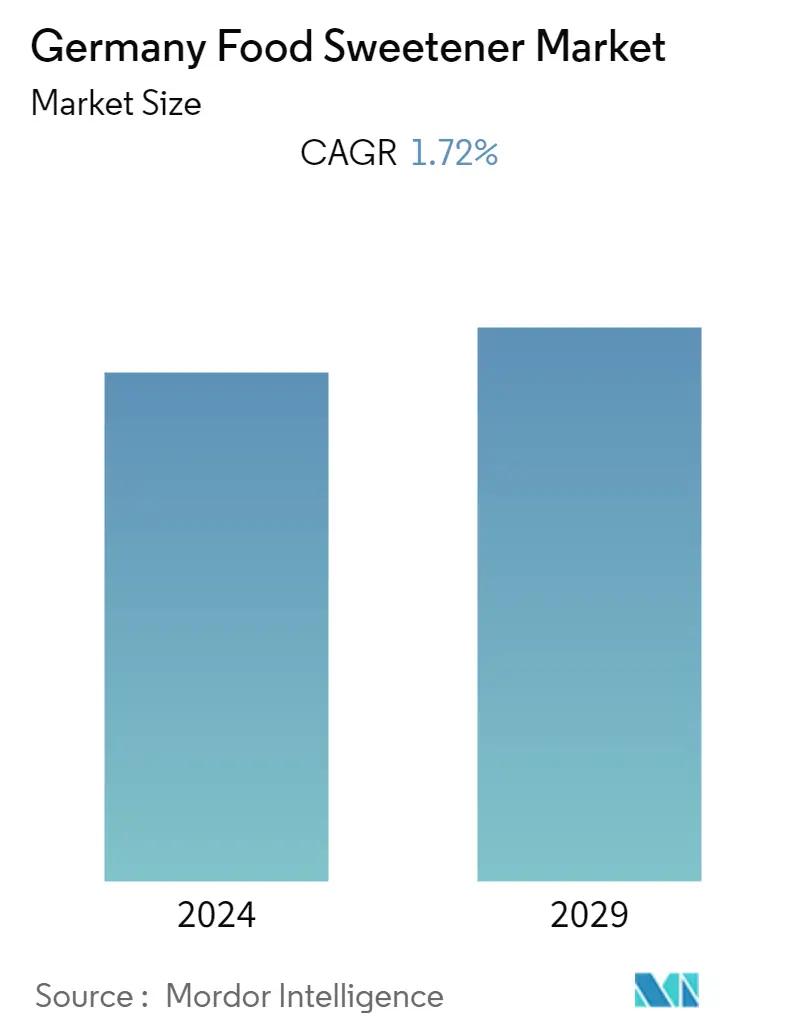Market Size of Germany Food Sweetener Industry

| Study Period | 2019 - 2029 |
| Base Year For Estimation | 2023 |
| Forecast Data Period | 2024 - 2029 |
| Historical Data Period | 2019 - 2022 |
| CAGR | 1.72 % |
| Market Concentration | Low |
Major Players.webp)
*Disclaimer: Major Players sorted in no particular order |
Germany Food Sweetener Market Analysis
The German food sweetener market is projected to record a CAGR of 1.72% over the next five years.
In Europe, Germany is the largest market for food sweeteners. An increase in the consumption of processed food products is driving the market's growth. The widespread adoption of food sweeteners across the food and beverage (F&B) sector can be attributed to the increasing demand for low-sugar and calorie consumer goods, such as diet coke, yogurt, ice cream, and grain-based desserts, which is one of the key factors driving the market's growth. The rising health consciousness and the increasing prevalence of obesity, diabetes, cardiovascular diseases, and other lifestyle-based ailments across the country further support this growth. The demand for processed and packaged food is increasing in both developed and developing regions of the world due to rising urbanization, a growing middle-class population, an increase in the number of working women, and rising disposable incomes. This trend may lead to an increase in the demand for food packaging and sugar processing solutions, which may fuel the demand for high-fructose corn syrup in food and beverage applications in Germany.
The introduction of natural sweeteners composed of organic ingredients, such as stevia and honey, to imitate conventional sugar's taste is another growth-inducing factor. Manufacturers are focusing on expanding their portfolios by including artificial and other sugar substitutes, such as xylitol, erythritol, and mannitol, in the formulation of confectionery items, which is supporting the market's growth significantly. Other factors, such as strategic collaborations among key players and rising investments in R&D activities, create a positive outlook for the German food sweetener market.
Germany Food Sweetener Industry Segmentation
Sweeteners are the various natural and artificial substances that impart a sweet taste to foods and beverages.
Germany's food sweetener market is segmented by type (sucrose, starch sweeteners, and sugar alcohols (dextrose, high fructose corn syrup, maltodextrin, sorbitol, xylitol, and other types) and high-intensity sweeteners (sucralose, aspartame, saccharin, cyclamate, ace-K, neotame, stevia, and others)) and application (dairy, bakery, soups, sauces and dressings, confectionery, beverages, and other applications). The report offers market sizes and values in (USD million) for the above segments.
| By Product Type | ||||||||||
| Sucrose | ||||||||||
| ||||||||||
|
| By Application | |
| Dairy | |
| Bakery | |
| Soups, Sauces and Dressings | |
| Confectionery | |
| Beverages | |
| Other Applications |
Germany Food Sweetener Market Size Summary
The German food sweetener market is experiencing growth driven by the increasing consumption of processed food products and a rising demand for low-sugar and low-calorie consumer goods. This trend is largely influenced by heightened health consciousness and the prevalence of lifestyle-related health issues such as obesity and diabetes. The food and beverage sector in Germany, being the fourth largest industry, is witnessing a shift towards healthier and sustainable nutrition options. The market is characterized by the adoption of natural sweeteners like stevia and honey, as well as artificial substitutes such as xylitol and erythritol, which are gaining popularity due to their health benefits. Strategic collaborations and investments in research and development are further enhancing the market's growth prospects.
The demand for convenience and processed foods is a significant driver for the food sweetener market in Germany, with factors such as urbanization, a growing middle-class population, and increased disposable incomes contributing to this trend. The market is fragmented, with major players like Cargill Inc., Tate & Lyle, and Organic Stevia GmbH leading the way through acquisitions, product launches, and joint ventures. The introduction of innovative sweeteners, such as Brazzein, and the expansion of production facilities for natural sweeteners like stevia are indicative of the market's dynamic nature. Despite the higher cost of natural sweeteners compared to artificial ones, regulatory approvals and consumer preferences are steering the market towards natural and low-calorie options, shaping its future trajectory.
Germany Food Sweetener Market Size - Table of Contents
-
1. MARKET DYNAMICS
-
1.1 Market Drivers
-
1.2 Market Restraints
-
1.3 Porter's Five Forces Analysis
-
1.3.1 Threat of New Entrants
-
1.3.2 Bargaining Power of Buyers/Consumers
-
1.3.3 Bargaining Power of Suppliers
-
1.3.4 Threat of Substitute Products
-
1.3.5 Intensity of Competitive Rivalry
-
-
-
2. MARKET SEGMENTATION
-
2.1 By Product Type
-
2.1.1 Sucrose
-
2.1.2 Starch Sweeteners and Sugar Alcohols
-
2.1.2.1 Dextrose
-
2.1.2.2 High Fructose Corn Syrup (HFCS)
-
2.1.2.3 Maltodextrin
-
2.1.2.4 Sorbitol
-
2.1.2.5 Xylitol
-
2.1.2.6 Others
-
-
2.1.3 High Intensity Sweeteners (HIS)
-
2.1.3.1 Sucralose
-
2.1.3.2 Aspartame
-
2.1.3.3 Saccharin
-
2.1.3.4 Cyclamate
-
2.1.3.5 Ace-K
-
2.1.3.6 Neotame
-
2.1.3.7 Stevia
-
2.1.3.8 Others
-
-
-
2.2 By Application
-
2.2.1 Dairy
-
2.2.2 Bakery
-
2.2.3 Soups, Sauces and Dressings
-
2.2.4 Confectionery
-
2.2.5 Beverages
-
2.2.6 Other Applications
-
-
Germany Food Sweetener Market Size FAQs
What is the current Germany Food Sweetener Market size?
The Germany Food Sweetener Market is projected to register a CAGR of 1.72% during the forecast period (2024-2029)
Who are the key players in Germany Food Sweetener Market?
Cargill, Incorporated, Tate & Lyle, Organic Stevia GmbH, Ingredion Incorporated and Denk Ingredients are the major companies operating in the Germany Food Sweetener Market.

